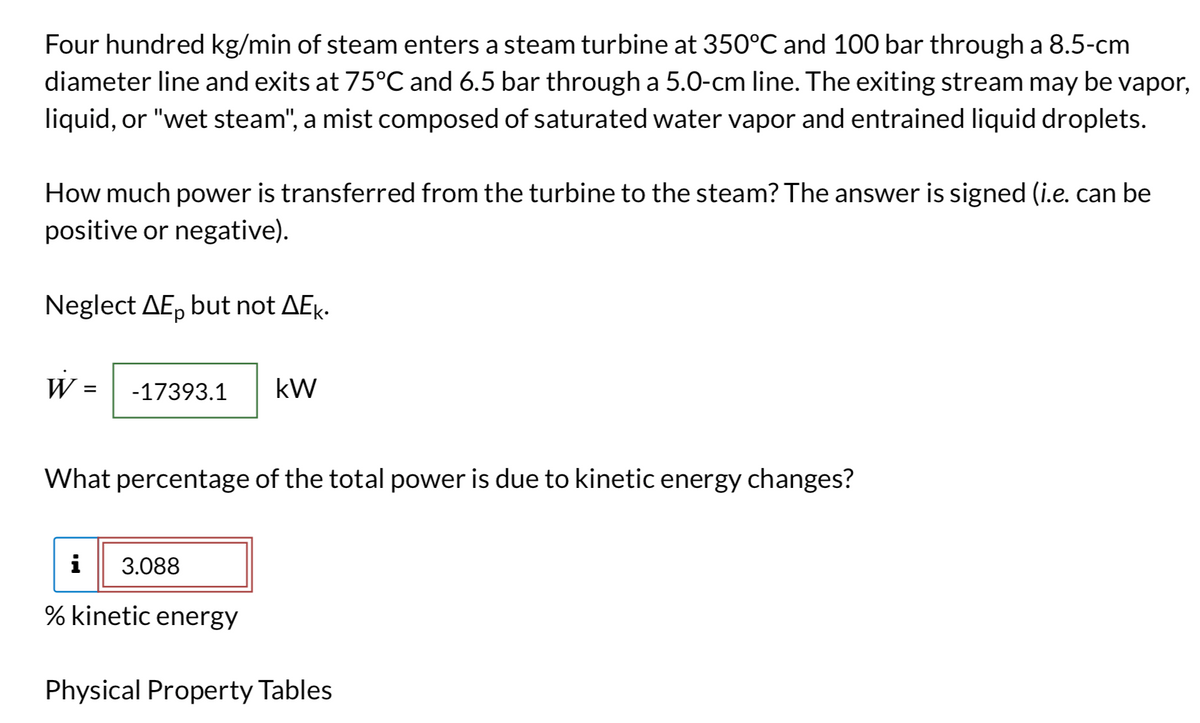Four hundred kg/min of steam enters a steam turbine at 350°C and 100 bar through a 8.5-cm diameter line and exits at 75°C and 6.5 bar through a 5.0-cm line. The exiting stream may be vapor, liquid, or "wet steam", a mist composed of saturated water vapor and entrained liquid droplets. How much power is transferred from the turbine to the steam? The answer is signed (i.e. can be positive or negative). Neglect AE, but not AEk. W = -17393.1 kW What percentage of the total power is due to kinetic energy changes? i % kinetic energy 3.088 Physical Property Tables
Four hundred kg/min of steam enters a steam turbine at 350°C and 100 bar through a 8.5-cm diameter line and exits at 75°C and 6.5 bar through a 5.0-cm line. The exiting stream may be vapor, liquid, or "wet steam", a mist composed of saturated water vapor and entrained liquid droplets. How much power is transferred from the turbine to the steam? The answer is signed (i.e. can be positive or negative). Neglect AE, but not AEk. W = -17393.1 kW What percentage of the total power is due to kinetic energy changes? i % kinetic energy 3.088 Physical Property Tables
Introduction to Chemical Engineering Thermodynamics
8th Edition
ISBN:9781259696527
Author:J.M. Smith Termodinamica en ingenieria quimica, Hendrick C Van Ness, Michael Abbott, Mark Swihart
Publisher:J.M. Smith Termodinamica en ingenieria quimica, Hendrick C Van Ness, Michael Abbott, Mark Swihart
Chapter1: Introduction
Section: Chapter Questions
Problem 1.1P
Related questions
Question

Transcribed Image Text:Four hundred kg/min of steam enters a steam turbine at 350°C and 100 bar through a 8.5-cm
diameter line and exits at 75ºC and 6.5 bar through a 5.0-cm line. The exiting stream may be vapor,
liquid, or "wet steam", a mist composed of saturated water vapor and entrained liquid droplets.
How much power is transferred from the turbine to the steam? The answer is signed (i.e. can be
positive or negative).
Neglect AE, but not AEk.
W:
= -17393.1 kW
What percentage of the total power is due to kinetic energy changes?
i 3.088
% kinetic energy
Physical Property Tables
Expert Solution
This question has been solved!
Explore an expertly crafted, step-by-step solution for a thorough understanding of key concepts.
This is a popular solution!
Trending now
This is a popular solution!
Step by step
Solved in 4 steps

Recommended textbooks for you

Introduction to Chemical Engineering Thermodynami…
Chemical Engineering
ISBN:
9781259696527
Author:
J.M. Smith Termodinamica en ingenieria quimica, Hendrick C Van Ness, Michael Abbott, Mark Swihart
Publisher:
McGraw-Hill Education

Elementary Principles of Chemical Processes, Bind…
Chemical Engineering
ISBN:
9781118431221
Author:
Richard M. Felder, Ronald W. Rousseau, Lisa G. Bullard
Publisher:
WILEY

Elements of Chemical Reaction Engineering (5th Ed…
Chemical Engineering
ISBN:
9780133887518
Author:
H. Scott Fogler
Publisher:
Prentice Hall

Introduction to Chemical Engineering Thermodynami…
Chemical Engineering
ISBN:
9781259696527
Author:
J.M. Smith Termodinamica en ingenieria quimica, Hendrick C Van Ness, Michael Abbott, Mark Swihart
Publisher:
McGraw-Hill Education

Elementary Principles of Chemical Processes, Bind…
Chemical Engineering
ISBN:
9781118431221
Author:
Richard M. Felder, Ronald W. Rousseau, Lisa G. Bullard
Publisher:
WILEY

Elements of Chemical Reaction Engineering (5th Ed…
Chemical Engineering
ISBN:
9780133887518
Author:
H. Scott Fogler
Publisher:
Prentice Hall


Industrial Plastics: Theory and Applications
Chemical Engineering
ISBN:
9781285061238
Author:
Lokensgard, Erik
Publisher:
Delmar Cengage Learning

Unit Operations of Chemical Engineering
Chemical Engineering
ISBN:
9780072848236
Author:
Warren McCabe, Julian C. Smith, Peter Harriott
Publisher:
McGraw-Hill Companies, The